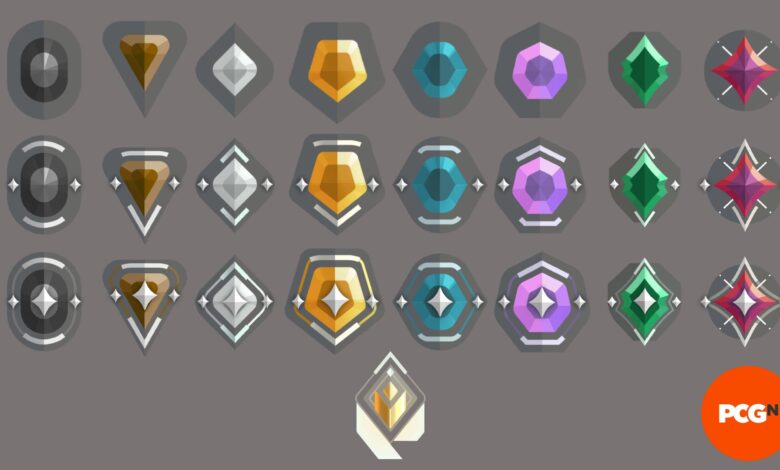Understanding Valorant Ranks in Order: A Complete Guide

Introduction to Valorant Ranks
Valorant Ranks in Order, the popular tactical first-person shooter developed by Riot Games, features a competitive ranking system that is essential for players seeking to engage in ranked matches. Understanding the structure and progression within this system is crucial for anyone looking to improve their gameplay and achieve higher tiers. The ranks in Valorant serve not only as a means of categorizing player skill levels but also play a significant role in matchmaking, ensuring players are paired with opponents of similar ability. This facilitates a balanced and competitive environment that enhances the overall gaming experience.
The rank system is divided into several tiers, with players progressing through these ranks based on their performance in competitive matches. Each rank reflects an accumulation of wins and losses, individual player skills, and team contributions. Consequently, grasping the importance of valorant ranks in order is fundamental for those aiming to climb the competitive ladder. Furthermore, these ranks provide a tangible measure of improvement and skill development, motivating players to refine their strategies and gameplay mechanics.
The purpose of this guide is to arm players with a comprehensive understanding of the ranks in Valorant, elucidating their significance and the best routes for advancement. By familiarizing themselves with the ranks and how they work, players can set realistic goals and track their progress effectively. This guide will cover each rank thoroughly, offering insights on rank-specific requirements and tips for ascending through the ranks, boosting confidence and competitiveness in matches. As we delve into the intricacies of Valorant ranks, players will gain valuable knowledge that can impact their success in this exhilarating game.
The Ranking System Explained
Valorant, developed by Riot Games, has established a structured ranking system designed to match players of similar skill levels and promote fair competition. At the core of the ranking system is the Matchmaking Rating (MMR), which assesses a player’s performance based on several metrics. MMR is adjusted after each match, taking into account the outcome, individual performance, and the relative skill levels of opponents.
Ranks in Valorant are categorized into several tiers, from Iron to Radiant, encompassing a total of eight ranks. Each main rank consists of three divisions, excluding Radiant, which has only one division. The progression through these ranks is influenced not only by the player’s win rate but also by individual contributions during matches, such as kills, assists, and overall impact on the game’s outcome.
As players engage in competitive matches, their win rates become a crucial element in determining their advancement. A player with a consistent win rate above 50% is likely to see an upward shift in their rank, whereas those with lower win rates may experience a decline. The balancing of wins and losses is vital, as it shapes the player’s MMR and ultimately dictates their rank placement.
Furthermore, performance during matches is evaluated through various statistics. Players are not only measured by the number of victories but also their contribution to the team’s objectives. Elements like successful strategy execution, teamwork, and the ability to secure crucial advantages can positively influence a player’s rank progression. The dynamic nature of the ranking system ensures that players are motivated to constantly improve their skills and adapt their gameplay to rise within the ranks of Valorant.
List of Valorant Ranks in Order
The competitive landscape of Valorant is defined by a hierarchical system of ranks that represents players’ skill levels. Understanding Valorant ranks in order is essential for players aiming to progress through the ranks and improve their gameplay. Starting from the lowest to the highest, the ranks are categorized as follows:
Iron: This is the lowest rank in Valorant. Players in this tier are usually new to the game and are in the process of learning the mechanics, map layouts, and gameplay strategies. Iron players typically exhibit basic shooting skills and a limited understanding of coordinated team play.
Bronze: Next in line is the Bronze rank. Players here have a slightly better grasp of the game but may still struggle with effective communication and teamwork. They begin to understand various agents and their abilities, although their overall impact may still be minimal.
Silver: Silver players start to develop a more detailed understanding of strategies and gameplay dynamics. They have a sound grasp of character abilities and can engage in team play more effectively. While they show improvement in aiming and tactics, they are still not consistent in their performance.
Gold: Players who reach the Gold rank demonstrate a solid understanding of the game’s mechanics. They consistently utilize agent abilities and demonstrate a strong sense of teamwork. Gold players often employ effective strategies but may struggle against opponents in higher ranks.
Platinum: As players progress to Platinum, they become more skilled and competitive. They understand advanced strategies, exhibit exceptional aim, and can adapt to various situations. Communication and teamwork are typically showcased more effectively at this level.
Diamond: Diamond players are highly skilled, often mastering multiple agents and tactics. Their gameplay reflects a tactical understanding of the game, as they frequently make smart plays. Players at this rank possess excellent decision-making skills and strong game sense.
Immortal: Immortal players are elite players who have a deep understanding of game mechanics, team coordination, and map control. Their performance is consistent against challengers at high levels, and they excel in competitive strategies.
Radiant: The highest rank in Valorant is Radiant, occupied by the top players in the game. Radiant players exhibit unparalleled skill, showcasing high levels of aim, game sense, and the ability to perform under pressure. They are often considered role models for aspiring players within the Valorant community.
An understanding of Valorant ranks in order helps players identify their current standing, strive for improvement, and set achievable goals within the competitive landscape. This information not only benefits individual players but also enhances the community’s overall gameplay experience.
Placement Matches: Your First Step into Ranks
In the competitive landscape of Valorant, placement matches play a crucial role in determining a player’s initial standing within the valorant ranks in order. These matches serve as a benchmark for skill assessment, effectively allowing the game to analyze a player’s capabilities before assigning them to a specific rank. Typically, players are required to participate in five placement matches at the outset of their competitive journey.
The evaluation of a player’s performance during these matches uses several criteria, including individual contributions to team success, kill-to-death ratios, and overall strategic execution. Notably, it is essential to perform well in these placement matches since they can significantly influence your beginning rank. A strong showing can result in a higher initial placement, whereas inconsistent or poor performances may lead to a demotion into lower tiers.
To excel in these critical games, players should approach placement matches with a strategy that focuses on teamwork and communication. Rather than fixating solely on personal performance metrics, working collaboratively with team members can lead to more successful outcomes. Employing effective communication strategies, such as callouts and sharing tactical insights, is paramount. Furthermore, understanding map layouts and practicing character abilities can enhance individual contributions and synchronize team efforts.
Additionally, it is advisable for players to maintain a positive mindset throughout these matches. The emotionally charged nature of competitive gaming can often lead to frustration, especially if results do not reflect the effort put in. Staying calm and adapting to the evolving dynamics of each match can facilitate better performance. By concentrating on these factors, players can increase their chances of achieving a favorable rank and pave the way for their overall progression within valorant ranks in order.
Rank Decay and Promotion: How It Works
The Valorant ranking system is designed to reflect a player’s skill and performance, which means that both rank decay and promotion are crucial aspects of maintaining an accurate representation of a player’s abilities. Understanding these mechanics allows players to navigate the ranks more effectively and avoid unnecessary demotion.
Rank decay occurs when a player remains inactive for an extended period. In Valorant, the inactivity period typically spans two weeks. If a player has not completed a ranked match within this timeframe, they risk losing their rank. The specifics of this system can vary, but generally, players can expect to drop one rank after two weeks of inactivity and additional ranks for prolonged periods. This structure encourages consistent play and ensures that ranks remain reflective of a player’s current skill level.
On the other hand, promotions within the Valorant ranks in order largely depend on a player’s performance in ranked matches. When a player consistently wins matches and performs well, they are more likely to earn sufficient competitive points to move up the ranks. This includes achieving a high match score, which takes into account kills, assists, and overall contribution to the team’s success. Notably, players often need to win a certain number of matches within their current rank to qualify for promotion to the next tier.
It is essential to understand that while winning is crucial for promotion, consistent performance is equally important. This ensures that players are not only ascending the ranks based on luck but also due to their skill and effort. By focusing on improving gameplay and maintaining activity levels, players can better navigate the complexities of rank decay and promotion, ultimately leading to a more satisfying gaming experience in Valorant.
Tips to Climb the Ranks in Valorant
For players looking to improve their standings within the Valorant ranks in order, effective strategies and disciplined practice are essential. A primary factor in climbing the ranks is communication. Valorant is a team-based tactical shooter, and informing teammates of enemy positions, potential strategies, and personal game plans can significantly enhance overall performance. Utilize voice chat or in-game signaling to keep your team informed, as clear communication fosters a collaborative environment critical for victory.
Teamwork is another pivotal element in ensuring success within the various Valorant ranks. Understanding your teammates’ play styles, strengths, and weaknesses can aid in developing cohesive strategies tailored to your group dynamics. Aim to play with consistent teammates whenever possible, as this fosters synergy and trust, which is crucial during high-stakes matches. Additionally, celebrating successes and learning from mistakes collectively reinforces teamwork, allowing for continued growth and adaptability.
Establishing a routine that encompasses dedicated practice time can also lead to improvement. Regularly engaging in aim training through specialized software or the game’s practice range can refine your shooting skills. Set specific goals during sessions to work on particular aspects, such as headshots or reaction time. Over time, this focused improvement can translate into better performance during competitive matches.
Furthermore, acquiring comprehensive map knowledge is vital for players eager to advance through the ranks. Familiarize yourself with each map’s layout, common chokepoints, and bomb sites. Understanding map dynamics will enable you to anticipate enemy movements and strategize effectively. By leveraging these insights and maintaining awareness of sightlines and key locations, you can gain the upper hand in engagements.
By implementing these fundamental strategies—communication, teamwork, practice routines, and map knowledge—players will be better equipped to navigate the intricacies of Valorant ranks in order, improving their chances of reaching higher tiers consistently.
Understanding Competitive Matchmaking
Competitive matchmaking in Valorant plays a crucial role in establishing a balanced and fair gaming environment. It is primarily designed to pair players with similar skill levels, ensuring that matches are competitive and enjoyable. The cornerstone of this system is the matchmaking algorithm, which evaluates a player’s performance through their rank and skill rating. This process begins when players enter a competitive queue, where they are subsequently matched against opponents who display similar ranks in order to create an equal opportunity for both sides.
The matchmaking algorithm considers several factors when creating matches. Key elements include players’ current ranks, overall match history, and individual performance metrics, such as kill-to-death ratios, damage dealt, and objective completion. By analyzing these variables, the algorithm aims to predict a player’s potential performance in a game, thereby enhancing the overall experience. Consequently, players within the same rank or close ranks are more likely to perform comparably, leading to more thrilling encounters.
The significance of ranks in match outcomes cannot be overstated. Players within the same ranks are expected to display similar skills, creating a team dynamic that is pivotal for collaboration and strategy execution. Higher-ranked players typically have a deeper understanding of game mechanics, map knowledge, and teamwork, which can drastically impact team success. Moreover, rank variations can influence the compositions required for effective play styles, leading to varied strategies based on players’ strengths and weaknesses.
In conclusion, understanding competitive matchmaking is essential for players looking to improve their performance in Valorant. By recognizing the correlation between ranks and match dynamics, they can better navigate the gaming landscape and strive towards ascending the Valorant ranks in order.
Common Challenges Players Face with Ranks
Ranking up in Valorant can be an exhilarating journey; however, it is fraught with various challenges that players must navigate to achieve higher valorant ranks in order. One of the most prevalent issues players face is encountering smurf accounts. Smurfing occurs when experienced players create new accounts to dominate less skilled opponents, leading to mismatched skill levels and ultimately frustrating gameplay experiences. This disparity can derail the ranking process for players who are genuinely striving to improve.
Another significant challenge is the presence of toxicity within the player community. Players often encounter teammates or opponents who engage in negative interactions, such as verbal harassment or unsportsmanlike conduct. This behavior not only affects individual morale but can also impact overall team performance, hindering the quest to climb the valorant ranks in order. Addressing toxicity starts with a strong mental approach; players are encouraged to focus on their gameplay and report negative behavior to maintain a fair gaming environment.
Skill disparity can also manifest within matches, leading to frustrations similar to those encountered due to smurfing. Players may find themselves matched with individuals whose skill levels vary drastically, complicating cooperative team play. This variance can result in lost matches, demoralization, and ultimately, stagnation in rank progression. To mitigate these effects, players should consider forming consistent squad teams where communication and synergy are improved. Developing specific strategies and practicing together can help balance out skill levels among friends, resulting in a more enjoyable environment as they pursue their desired valorant ranks in order.
By understanding and addressing these challenges, players can enhance their overall gaming experience and increase their chances of achieving their rank goals. For those passionate about improving their skills and strategies, remaining focused on personal development is key to overcoming these obstacles.
Conclusion: The Journey Through Valorant Ranks
Understanding Valorant ranks in order is essential for players who wish to navigate the competitive landscape of this popular first-person shooter. The rank system not only serves as a measure of skill but also as a pathway for players to track their progress and set clear goals. Each rank, from Iron to Radiant, represents a different level of proficiency, and players will find themselves facing unique challenges at each stage of their journey.
Throughout our exploration of Valorant ranks, we have discussed various strategies that players can implement to improve their rank. These strategies include focusing on teamwork, mastering agent abilities, and refining game mechanics. Players are encouraged to practice consistently and to be mindful of their strengths and weaknesses. By doing so, they can enhance their gameplay and elevate their ranks more effectively.
It is important to note that the ranking system can often feel daunting, especially for beginners. However, every player must remember that the journey through Valorant ranks is not merely a struggle for higher placement; it also offers opportunities for personal growth and enjoyment of the game. Players should strive to engage with their teammates, learn from each match, and appreciate the thrill of competition.
In conclusion, understanding the structure of Valorant ranks in order helps players appreciate the ranking system and its significance. With commitment to improvement and a focus on the strategies we’ve discussed, players can steadily progress through the ranks while enjoying the rich gameplay that Valorant offers. Embrace the challenges that come with each match, and remember that every step taken in the ranking system is a step toward becoming a better player.
You May Also Read This Usaworldtoday.




